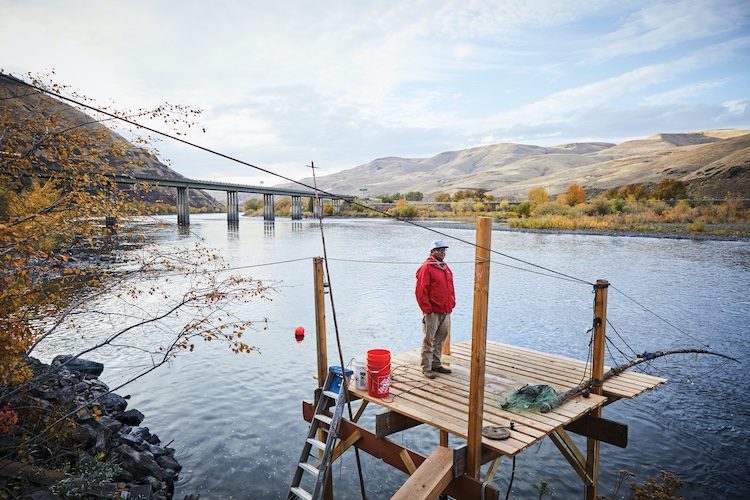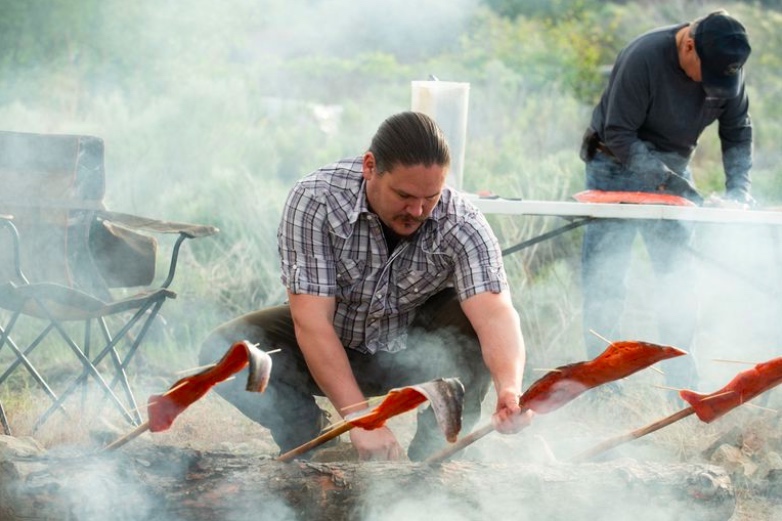forum
library
tutorial
contact

In a Major Shift, Northwest Tribes -- Not US Officials
-- Will Control Salmon Recovery Funds
by Tony Schick
Herald and News, December 21, 2023
|
the film forum library tutorial contact |

|
In a Major Shift, Northwest Tribes -- Not US Officials
by Tony Schick
|
The White House did little for dam removal
because it punted the question to Congress.
 The Biden administration punted on key demands from Indigenous leaders to tear down hydroelectric dams hindering salmon. But tribes won control over $1 billion for other salmon efforts.
The Biden administration punted on key demands from Indigenous leaders to tear down hydroelectric dams hindering salmon. But tribes won control over $1 billion for other salmon efforts.
When the Biden administration said it had reached a "historic" legal deal with Northwest Indigenous tribes last week to save endangered salmon, no one could agree on what it meant for the tribes' costliest and most controversial demand: the removal of four hydroelectric dams that hinder fish from their migration out to sea and home to reproduce.
Some said the deal, in promoting renewable energy that can replace hydropower, virtually ensures the dams on Washington's Snake River will come down. Others said the White House did little for dam removal because it punted the question to Congress.
Largely overlooked in the debate was one seemingly technical provision that is far less open to interpretation and of great importance to the tribes. Not only does the deal offer $1 billion in new funding for Columbia River salmon restoration, but for the first time it also grants states and tribes control -- not the Bonneville Power Administration, which sells hydropower from Northwest dams -- over how that money gets spent.
The shift, while not flashy, addresses one of the biggest sources of frustration for tribes that ProPublica and Oregon Public Broadcasting highlighted in the investigation "Broken Promises."
"We don't need an energy agency to be telling us how this fund should be utilized," said Yakama Nation council member Jeremy Takala.
The Bonneville Power Administration, which has historically decided how salmon recovery money gets spent, is under a sometimes conflicting mandate: to sell hydropower from federal dams and operate as a for-profit business, but also to save salmon harmed by that hydropower production.
The Oregon Public Broadcasting and ProPublica investigation found that Bonneville time and again prioritized its business interests over efforts to restore salmon populations. It actively pushed back on tribal initiatives and flatlined budgets in ways advocates said starved recovery efforts, even as the agency raked in record revenues.
Under the new agreement, Bonneville will invest $300 million over 10 years into salmon programs, including habitat restoration and much-needed upgrades to fish hatcheries, overseen by tribes and the states of Oregon and Washington. Companies and families that buy power from Bonneville will pay some of the cost in the form of an estimated rate increase averaging 0.7 %, and the agency will recoup the rest by selling more power to California.
That comes on top of a previously announced $200 million that Bonneville agreed to pay for a separate tribal plan to reintroduce salmon in areas blocked by dams. Additional money will come from the federal budget, rather than Bonneville ratepayers. In all, the Biden administration says it expects the government to spend $1 billion on state and tribal salmon recovery in the next decade.
Apart from that $1 billion, the administration also said it would look at doubling total fish and wildlife spending to meet all the needs identified by states and tribes, with the money to come from U.S. taxpayers, via Congress, and not customers of Bonneville's power.
Plenty of money has already been spent on efforts to remove threats to salmon other than dams -- digging new stream channels and placing downed logs in them for example -- with little to show for it.
But programs run by the Northwest's tribes have produced some of the few success stories. State fish and wildlife employees have often worked collaboratively with tribes on those projects.
 With the new agreement, Bonneville will pay an annual lump sum that states and tribes will decide independently how they'll spend.
With the new agreement, Bonneville will pay an annual lump sum that states and tribes will decide independently how they'll spend.
Corinne Sams, a member of the governing board of the Confederated Tribes of the Umatilla Indian Reservation and chair of the Columbia River Inter-Tribal Fish Commission, said the tribes have already identified $1 billion in backlogged projects in the Columbia basin.
"For far too long, preventing salmon extinction has been viewed as a cost. Salmon restoration needs to be considered an investment in our shared future," Sams said.
Sams said she saw an acknowledgment of tribal sovereignty and expertise that she never had before during the negotiations, including visits by several White House staff members to traditional fishing grounds and restoration sites.
"They actually got to see and feel our connection to our first foods and our resources, and how we care for them in our daily lives," Sams said. "They were able to witness that, and that's never happened."
Other provisions in the agreement, such as exploring new sources of energy other than dams in the region, also give priority to projects started by tribes.
Shannon Wheeler, chair of the Nez Perce tribe, said he was disappointed the agreement didn't assure that the Snake River dams will be breached to help salmon. But he said that in giving tribes control over funding, the agreement is an acknowledgment the U.S. has failed to honor tribal sovereignty in salmon recovery. Government treaties in the 1850s promised that the tribes' access to salmon, and their way of life, would be preserved.
"It's an understanding that the tribal position and expertise in this area needs to be considered," Wheeler said. "I think that's an important step in the right direction."
Bonneville officials did not address the move to give tribes and states increased control over salmon spending when asked.
A spokesperson instead provided a statement from the agency's chief executive officer, John Hairston, praising the agreement as a whole: "BPA sought to provide our ratepayers operational certainty and reliability while avoiding costly, unpredictable litigation in support of our mission to provide a reliable, affordable power supply to the Pacific Northwest."
The Public Power Council, a coalition of utilities that buys electricity from Bonneville, has been adamantly opposed to the agreement. The council said it's not concerned about the increased funding for salmon recovery or giving control of the spending to tribes. But it is concerned about other provisions.
"We cannot emphasize enough that this is but one change," the council said in a statement about the increased salmon funding, "and there is still substantial uncertainty in many key areas."
Opponents of the legal agreement, including the Public Power Council, are particularly concerned that it leaves supporters of dam removal the option to file new lawsuits if they feel it's necessary.
In the past, when Bonneville had struck funding agreements with tribes, those deals were contingent on promises that tribes wouldn't sue over the dam system. Some tribes signed those agreements to pursue habitat restoration while others did not and stayed in court. But under this agreement, the additional funding has no contingencies. It only says the current lawsuit alleging violations of the Endangered Species Act is on hold for five years.
Advocates for keeping the Snake River dams also are unhappy with the Biden administration's promise to explore future alternatives to hydropower in the Northwest. The industry has said replacing the dams with other sources could drive up electric rates by 40%.
Tribal leaders say the Northwest's unusually cheap electricity only exists thanks to hydropower, which is generated at the expense of salmon.
For Takala, the agreement with the Biden administration represents an opportunity for tribes to show the federal government the way toward healing the damage 20th-century dam construction inflicted.
"Displaced tribal members, impacted salmon runs -- the list goes on of impacts that we're still seeing to this day in some of the broken promises that haven't been lived up to," Takala said. "Yet, this gives us an opportunity to show the region, probably show the country, this could be done in a responsible manner."
learn more on topics covered in the film
see the video
read the script
learn the songs
discussion forum
